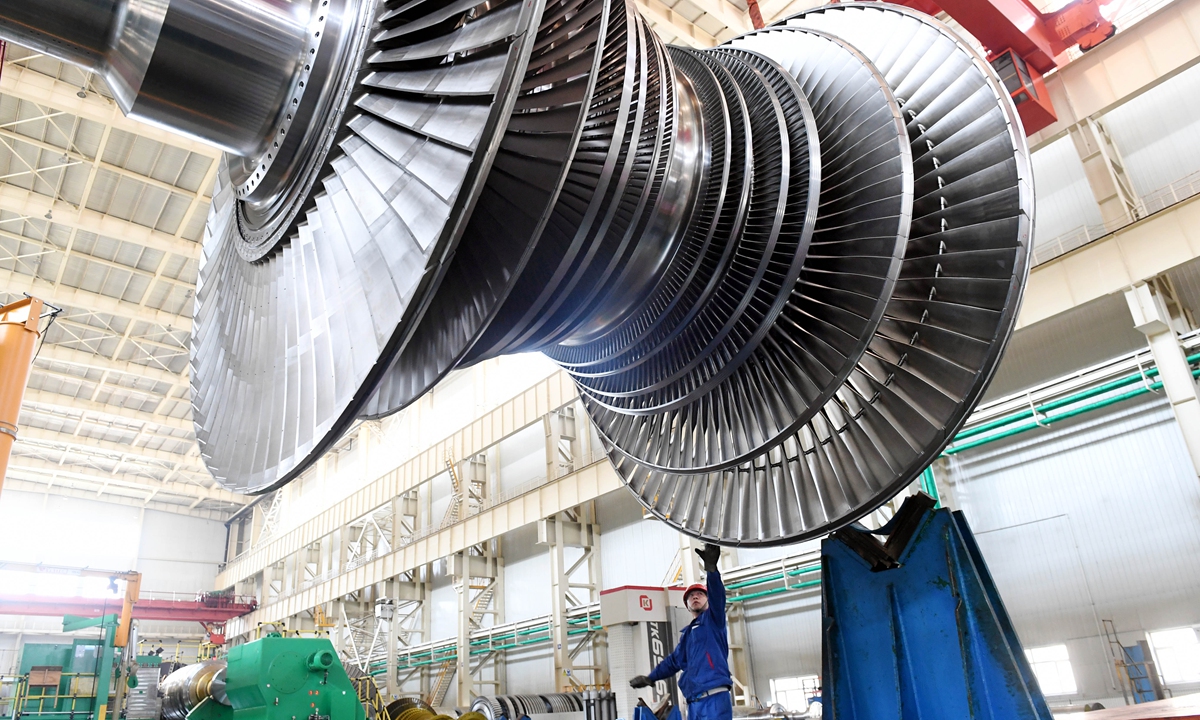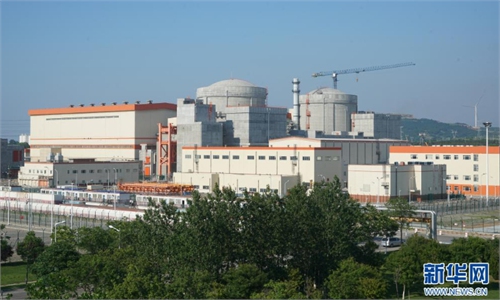Provinces roll out policies in Q2 growth sprint, as experts expect full-year GDP growth to exceed 6%

Workers hoist a giant component of a turbine at a plant of Harbin Turbine Co in Harbin, Northeast China's Heilongjiang Province on May 23, 2023. China's equipment manufacturing sector saw rapid expansion in April with a year-on-year growth rate of 13.2 percent. Photo: VCG
Chinese provinces have intensively rolled out policies to expand domestic demand, stabilize manufacturing growth and boost effective investment in a full-speed sprint to achieve notable development in the second quarter. Experts are upbeat about China's stable economic recovery and long-term bright prospects, projecting the economy will undoubtedly grow above 6 percent in 2023.
In a meeting held on Monday, the local government of Shijiazhuang, capital of North China's Hebei Province, called for efforts to strengthen monitoring the operations of major industries and enterprises, increase the resilience and modernization of industrial and supply chains, increase support for enterprises and stimulate their innovation and entrepreneurship.
As part of a raft of measures to bolster the industrial economy, Nanning, South China's Guangxi Zhuang Autonomous Region recently said that it will award 100,000 yuan ($14,070) to each leading enterprise that purchases products worth 10 million yuan or more from micro, small and medium-sized enterprises in the second quarter.
Enterprises that have completed industrial investment of 40 million yuan over the period will get 30,000 yuan as a reward.
Other provinces like Southwest China's Sichuan Province, Northwest China's Gansu Province and Central China's Hubei Province have announced preferential measures to consolidate the economic recovery's foundation and ensure the achievement of the annual economic and social development goals.
"These measures are timely, will greatly increase the confidence of manufacturers and promote a continuous economic recovery in the second quarter," Cao Heping, an economist at Peking University, told the Global Times on Wednesday.
He projected that the country's GDP growth rate may reach 8 percent in the second quarter given the lower year-earlier base, and the GDP growth rate for 2023 as a whole will probably exceed 6 percent.
While overall economic operations are improving, some macroeconomic indicators showed fluctuations. For example, the purchasing managers' index (PMI) for China's manufacturing sector came in at 48.8 in May, down from 49.2 in April, remaining in contraction territory, data from the National Bureau of Statistics (NBS) showed on Wednesday.
However, the services activity index stood at 54.5, maintaining expansion in May, according to the NBS.
"Driven by the strong rebound of the services sector, the comprehensive PMI remains in the expansion zone, showing that the Chinese economy is still in the recovery lane and the overall momentum is gaining strength," Zhou Maohua, an economist at Everbright Bank, told the Global Times on Wednesday.
More measures are needed to stabilize employment and increase incomes to stimulate consumers' spending potential, Zhou said, noting that supportive policies including tax and fee cuts are needed for extending the services sector recovery.
"Supply-side structural reform should be deepened to provide quality and attractive products and services to meet the demand of consumption upgrading," Zhou said. He said a raft of policies to boost the healthy development of the real estate sector should be implemented, while boosting big-ticket consumption like automobiles and home appliances.
A meeting convened by the Political Bureau of the Communist Party of China Central Committee on April 28 pointed to efforts in making proactive fiscal policy more effectual and prudent monetary policy more targeted and effective so as to create synergy for expanding demand.
The guiding role of government investment and policy incentives should be leveraged well to effectively stimulate private investment, the meeting said.
On May 15, the People's Bank of China(PBC), the central bank, pledged to make full efforts to keep economic growth, employment and prices stable with effective monetary and credit policies.
The central bank will make the country's prudent monetary policy more targeted and effective, and maintain reasonably ample liquidity to expand domestic demand and provide solid support for the real economy, according to its first-quarter monetary policy report.
Lian Ping, chief economist and head of the Zhixin Investment Research Institute, predicted that the central bank may continue to add liquidity to the banking system through small-scale operations of the medium-term lending facility.
"The PBC may cut the reserve requirement ratio by 0.25 percentage points, if the Chinese economy maintains a stable recovery in the second half of 2023 and requires more liquidity," he said.
Lian said that the authorities should strengthen support for consumption, and may consider relending to consumption to reduce commercial banks' cost pressure.
Meanwhile, the authorities could step up financing support for industries and enterprises that create more jobs, while offering credit support for graduates' innovation and entrepreneurship.


